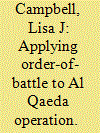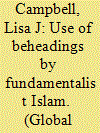|
|
|
Sort Order |
|
|
|
Items / Page
|
|
|
|
|
|
|
| Srl | Item |
| 1 |
ID:
060709


|
|
|
| 2 |
ID:
093825


|
|
|
|
|
| Publication |
2010.
|
| Summary/Abstract |
Today, analysts of the postmodern era recognize that worldwide conflicts are increasingly influenced by the interaction between terrorists, criminals, gangs, and private armies and that this interaction is a threat to the nation state. Now, a related threat is coming into play - one that involves all of these types of groups being represented at once in a single adversary. One such multifaceted group that is in the forefront is Los Zetas, a band of Mexican cartel enforcers that cannot be easily categorized, assessed, or targeted. Within broad categories of a multitude of irregular groups, Los Zetas embodies such capabilities as extensive compartmentalized networking, pervasive intelligence and counterintelligence capabilities, amassing of advanced weaponry, brutal tactics, top level military and police training, and the ability to undermine state governments and control large swaths of territory. Los Zetas, if left unchecked and unexamined, could potentially become a great security problem for Mexico, the US, and Central America. This essay provides an operational assessment that explores Los Zetas using various criteria traditionally used by nation state militaries, and more recently by Terrorism Early Warning Groups, to assess opposing forces (OPFOR). The purpose of this operational assessment is to provide a baseline understanding of Los Zetas that would make them less imposing and more targetable.
|
|
|
|
|
|
|
|
|
|
|
|
|
|
|
|
| 3 |
ID:
093830


|
|
|
|
|
| Publication |
2010.
|
| Summary/Abstract |
This essay provides an overview of those incidents of torture and beheadings linked to the Mexican cartels and their mercenary and gang affiliates taking place both within Mexico and the United States. Specific forms of torture are discussed as well as the most likely victims and perpetrators. Beheadings, primarily taking place only in Mexico, are also analyzed with supporting database information provided. The occurrences of torture and beheadings tied to these cartels, both in Mexico and more recently across the border into the United States, beg the question of the context in which they are being conducted. Most cases of torture or beheading are regarded as primarily secular in nature - a terrorist tactic tied to economic or political gain. In an even more macabre twist, however, certain instances have been seen as intertwined with a group's belief system, performed in ritual fashion to fulfill religious or spiritual demands. This suggests that the emergent Mexican narcocultos that are evolving may further increase drug war violence to new levels of brutality heretofore unseen.
|
|
|
|
|
|
|
|
|
|
|
|
|
|
|
|
| 4 |
ID:
077345


|
|
|
|
|
| Publication |
2006.
|
| Summary/Abstract |
Beheadings have made a dramatic resurgence in the past four years especially with the introduction of videotaped executions broadcast in the mass media. The use of beheadings has a longstanding history. Beheadings have been used in a state and non-state capacity, for punishment or intimidation, against leaders, civilians and warring combatants, during times of peace and that of upheaval. Beheadings today reproduce the characteristics of past beheadings as well as deviate from them. Contemporary beheadings have taken on a more criminal nature while beheadings of the past had more legitimacy and some even were considered honorable. Current beheading tactics include unexpected and illegal targets, unorthodox and barbaric techniques, and irregular display to an unprepared public. Although Islamic militants are the predominant beheaders, there is evidence that beheadings are being conducted by non-Islamic entities and in unexpected locations. If the current trend in the use of beheadings continues, it will be necessary to develop countermeasures, which will be facilitated with an understanding of the political, cultural, and criminal motives of the beheading offenders along with their tactics
|
|
|
|
|
|
|
|
|
|
|
|
|
|
|
|
|
|
|
|
|